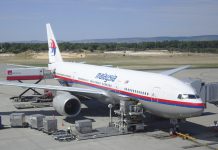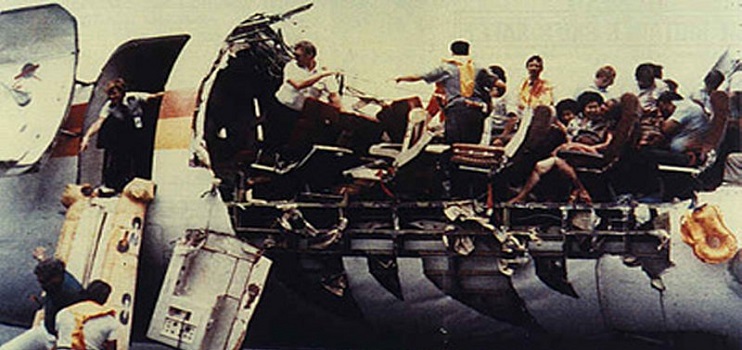When aviation safety is at issue, silence – from passengers – is certainly not golden. In recent years airlines and civil aviation authorities have developed complex reporting systems to speed the flow of critical safety information among pilots, mechanics, airlines and regulators.
The motto of all those efforts is straightforward: “See Something, Say Something.”
But missing from the process, at least formally, are airline passengers. In this post-9/11 society security officials now encourage flyers to report anything that looks out of the ordinary be it person or package. But the airline industry is almost silent when it comes to encouraging passengers to speak up when they see something airplane-related that looks strange.
“They haven’t taken it to the next step,” says former U.S. National Transportation Safety Board Member John Goglia. He says we need to create a process “by which passenger information would also be plugged in.” Goglia adds that he understands airlines could get “a lot of passenger comments that mean nothing. But…every once and a while you’re going to get a comment that has significance to it.”
Once, as a cabin crewmember on a flight awaiting departure from the wintry U.S. city of Denver, Colorado, Sara Nelson, now international president of the Association of Flight Attendants, responded to a passenger’s call button. “He said he thought he saw some ice build-up on the wing,” she remembers. She took a look out the window and headed for the flight deck. “The first officer (co-pilot) came back… and, indeed, there was concern.” The aircraft was de-iced again.
Goglia recounts a somewhat similar scenario when he was on an aircraft awaiting takeoff from the snowy Midwestern city Indianapolis, Indiana in the U.S. “I was sitting over the wing and saw the snow build up pretty good and could see where it was at the point that it was [concerning]. I actually got up. I was in a window seat. So I climbed over two people and…and was making my way towards the cockpit when one of the pilots came back. And I said, ‘I was just coming up and let the flight attendant know you need to go back and be de-iced.” The pilot responded, “I was coming back to look. Thanks.” The aircraft took an hour’s delay while ground crews de-iced it. But often passengers don’t speak up.
Hell Over Hawaii
On April 28, 1988, Aloha Airlines Flight 243 was 24,000 feet above the Pacific en route from the U.S. city of Hilo, Hawaii to Honolulu when the unthinkable happened and an explosive decompression rips 18 feet of fuselage from the top of the 737-200. Ninety-five souls are on board. One of them, a flight attendant, is swept overboard to her death. The 737 made a miraculous emergency landing at Maui without further loss of life.
The United States National Transportation Safety Board said the probable cause was Aloha’s failure “to detect the presence of significant [structural] disbanding and fatigue.”
In the wake of Flight 243, it emerges that a passenger stated that as she was boarding the airplane through the jet bridge at Hilo, and observed a fuselage crack. That crack lurked in an upper row of rivets, along what’s called a lap joint, about half way between the cabin door and the edge of the jet bridge hood. The accident report noted that she made no mention of the observation to the airline ground personnel or flight crew.
Why Passengers Don’t Speak Up
Marc Berman is a 100,000-mile frequent flyer, CEO and managing partner of The Mallett Group, a U.S.-based loyalty and relationship marketing firm. What makes his insights particularly penetrating, however, is that as a licensed independent clinical social worker he has a grounding in psychology.
Berman believes passengers often don’t speak up when they spot something unusual because many of them “have become very passive and do not question an airline’s [safe] operations.” Ironically, this passivity is pegged to the industry’s “fantastic safety records. People put their faith [in the airline]. I think there’s some denial there. Everyone wants to believe they’re going to be okay.”
That warm, fuzzy blanket believes Berman is ripped apart only when “an egregious sort of problem…makes someone speak up.”
BA’s Close Call
On May 24, 2013 a British Airways A319 with 80 aboard took off from Heathrow for Oslo when the cowl doors covering both engines are wrenched from the twin-engine Airbus.
According to the report realesed last week by the United Kingdom’s Air Accidents Investigation Branch (AAIB), the crew turned back to LHR. On approach to Runway 27R leaking fuel from a damaged fuel pipe on the starboard, or right side, engine ignited.
Here’s where passenger input comes into play. According to the AAIB report, “Several passengers reported that they had attempted to inform a member of cabin crew about the leaking fluid from the right engine. It is unclear when or how the passengers attempted to draw this to the attention of the cabin crew, or indeed which cabin crew member(s) were involved, but it is evident from photographs and passenger reports that the fuel leak was clearly visible through the cabin windows. Despite these cues, information regarding the fuel leak was not assimilated by the cabin crew and not passed to the flight crew as required by the operator’s SOPs (standard operating procedures).
The pilots remained unaware of the fuel leak until the ECAM (Electronic Centralized Aircraft Monitor) fuel imbalance alert was triggered. Had the flight crew been made aware of the fluid leak from the right engine at an earlier stage, they might have been able to identify the fuel leak more quickly and could have taken appropriate action to mitigate the severity of the event.
“The operator (British Airways) has…a procedure for cabin crew to report cabin emergencies to the flight crew and provides new entrant cabin crew with basic aircraft knowledge in accordance with EASA (European Aviation Safety Agency) practices. However, on this occasion, the training and procedure were unsuccessful in ensuring that vital information on the state of the aircraft was acquired by the cabin crew and made available to the commander,” said the report.
Thanks to some superb airmanship on the part of the cockpit crew the Airbus landed safely back at Heathrow. There were no injuries.
In the wake of the incident, the AAIB recommended British Airways amend its pilot and cabin crew “training, policies and procedures regarding in-flight damage assessments and reporting by cabin crew.”
Passenger Input In The Digital Age
One particularly pointed lesson learned from the BA incident is that in this digital age potentially every passenger is a reporter or video producer.
Peter Goelz is in a prime position to know. He’s former managing director of the U.S. National Transportation Safety Board, and current senior vice president of the Boston-based crisis communications consulting firm O’Neill and Associates. “The world has changed dramatically, particularly over the last ten years,” he says. “The ubiquity of recording devices,” has altered the informal rules of the game when it comes to passenger input.
Consider the BA incident and the photos passengers took of fuel erupting from the right side of the aircraft. “In terms of safety…that sort of crowd-sourcing puts considerable pressure on aircraft crewmembers to take these kind of inquiries seriously.” Where once upon a time Goelz says the flight attendant might have simply said, “‘Ma’am (or sir), I understand. We’ll get to it. Everything is under control,’” now the passenger may have a digital photo or tape of the offending problem.
Goelz further argues that since 9/11, “the whole issue of how you respond to passenger concerns has changed.” Passengers are encouraged to be part of the security effort by suspicious people or packages. Goelz sees scant difference between reporting potential safety issues and reporting suspected security lapses. “You don’t want people to sit on [potential safety information].” While conceding a sudden fountain of passenger-generated information could be a “pain in the neck” for airlines, the former NTSB official asserts something fundamental: Passengers “have a right to ask questions.”
Virtually all the experts AirlineRatings.com interviewed for this story agree that ‘See Something, Say Something’ needs to be something more than a slogan. AFA’s Sara Nelson says, “In terms of what we can do to get [passengers] engaged, perhaps the safety briefing, those initial safety instructions” about seat belts, oxygen masks and exit locations should add a more general admonition: ‘See Something, Say Something.’
Marc Berman contends the concept could be seen by particularly passive passengers as “permission” to speak up.
Permission or not, indications are we may well be entering a new era where passengers could save lives by speaking up!
























